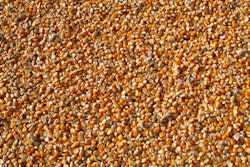
The U.S. Department of Agriculture has released its May 2023 Outlook for U.S. Agricultural Trade.
U.S. agricultural exports in fiscal year (FY) 2023 are forecast at $181 billion, down $3.5 billion from the February forecast.
This revision is driven by decreases in corn, wheat, beef, and poultry exports.
- Corn exports are forecast $2.1 billion lower to $14.5 billion on lower unit values and volumes as Brazil is poised to harvest a record second crop corn.
- Wheat exports are projected down $900 million to $7.4 billion due to lower volumes and unit values, as well as increased competition.
- Overall grain and feed exports are projected $3.3 billion lower at $40.5 billion.
- Total livestock, poultry, and dairy exports are projected to decrease by $1.2 billion to $39.3 billion, as declines in beef and poultry exports more than offset increases in dairy exports.
- Soybean exports are projected up $300 million to $32.3 billion on slightly higher volumes.
- Overall oilseed and product exports are forecast $100 million higher to $43.5 billion.
The export forecast for China is unchanged at $34 billion from February.
Exports to Mexico are projected up $500 million to $28.5 billion, whereas exports to Canada remain unchanged at $27.8 billion.
U.S. agricultural imports in FY 2023 are projected at $198 billion, down $1 billion from the February forecast.
This decrease is primarily driven by horticultural, livestock, dairy and poultry product imports.
Brazil's corn crop becomes price competitive
Brazil is forecast to have a record production for its upcoming safrinha crop to be harvested starting in June 2023, which has eased global prices and made Brazil’s corn more price competitive than U.S. corn.
Sorghum exports are forecast at $800 million, unchanged from the previous quarter.
Feeds and fodders exports are forecast at $10.6 billion, down $100 million from the February forecast, as lower volumes more than offset higher unit values.
U.S. has smaller-than-expected winter wheat production
Wheat exports are forecast at $7.4 billion, down $900 million from the previous forecast on lower volumes and unit values.
U.S. wheat export volumes are forecast down significantly due to smaller-than-expected winter wheat production for 2023/24 on higher acreage abandonment and reduced yields amidst drought conditions.
U.S. wheat exports also face increased competition in Western Hemisphere markets from regional competitors Canada and Argentina.
Unit values are forecast lower on global price pressure based on generally favorable conditions to date for Northern Hemisphere wheat crops outside the U.S. including Canada, the European Union (EU) and Russia.
Oilseed exports increase
Oilseed and products exports are forecast at $43.5 billion, a $100 million increase from the February forecast.
Soybean export value is up marginally to $32.3 billion on a slightly improved trade volume outlook.
Soybean meal export volume also increased, with export value up $100 million to $6.3 billion.
Soybean oil exports are reduced $200 million from the previous forecast as export volumes are forecast at the lowest levels in decades. This reflects a large premium for U.S. soybean oil compared with competitors due to strong biomass-based diesel demand in the U.S. Other oilseeds are down on reductions in volumes of cottonseed, rapeseed oil and industrial fatty alcohols.
Ethanol exports remain unchanged
Ethanol exports remain unchanged from February forecast at $3.6 billion. This is 11% below last year’s record value, but still the second highest on record.
Historically high export unit value is supported by persistently elevated corn and gasoline prices.
Export volume is forecast one-quarter below the 2018 record of 1.6 billion gallons.
U.S. exports to South Korea, the EU, India, Mexico, Nigeria and nearly all key markets falter due to inflation and cost-of-living squeeze, which dampens fuel demand, and weak manufacturing activity, which lowers demand for ethanol used in nonfuel applications.
Competitive pricing from Brazil in previous months undercut U.S. sales to several markets and sales to Brazil remain minimal.
Canada remains the current bright spot for U.S. ethanol exports mainly due to higher fuel blending in Ontario. Sales volume to Canada for the first six months of the fiscal year were up 35% pushing its share of U.S. ethanol exports to 40%.

















